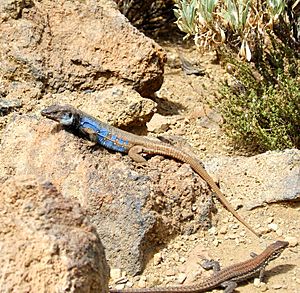Gallotia facts for kids
Quick facts for kids Gallotia |
|
|---|---|
 |
|
| Tenerife lizard (Gallotia galloti galloti) male (top) and female |
|
| Scientific classification |
|
| Kingdom: | Animalia |
| Phylum: | Chordata |
| Class: | Reptilia |
| Order: | Squamata |
| Family: | Lacertidae |
| Subfamily: | Gallotiinae |
| Genus: | Gallotia Boulenger, 1916 |
| Species | |
The Gallotia are a special group of lizards, also known as wall lizards. They live only on the Canary Islands, which are off the coast of Africa. These lizards have been evolving on these islands for over 20 million years. That's a very long time!
What makes Gallotia lizards unique is that they eat a lot of plants. Many of them are also known for being very large. Scientists used to think they became big because they lived on islands. This idea is called insular gigantism. However, new discoveries suggest their ancestors might have already been large and eaten meat before they even reached the islands.
Contents
Where do Gallotia Lizards Live?
Scientists divide the Gallotia lizards into two main groups. These groups are based on when and where they first arrived on the Canary Islands. The first group colonized the older eastern islands like Lanzarote, Fuerteventura, and Gran Canaria. This happened about 10 to 20 million years ago.
The second group arrived later, less than 10 million years ago. They settled on the younger western islands, such as Tenerife, La Palma, La Gomera, and El Hierro. Both of these groups have both large and small lizard species.
How Scientists Track Their History
Scientists use something called mtDNA analysis to study these lizards. This is like looking at their family tree through their DNA. It helps them understand how the lizards spread across the islands.
For example, studies show that the small G. atlantica lizard first appeared on Lanzarote and Fuerteventura. Then, some of these lizards moved to Gran Canaria. There, they evolved into the larger G. stehlini species.
The lizards on the western islands also came from the eastern islands. They split into two types: medium-sized and very large, or "giant," species. Today, many of the giant species are very rare. Some, like G. auritae on La Palma, might even be extinct.
Giant Lizards of the Past
Long ago, there were even bigger Gallotia lizards. Scientists found old bones of these giant lizards. Two famous types were called G. goliath and G. maxima. At first, people thought G. goliath lived on many islands. They also thought G. maxima was a separate species found only on Tenerife.
However, further research showed that G. maxima was actually the same as G. goliath. It seems G. goliath mostly lived on Tenerife. Scientists even found a mummified (naturally preserved) giant lizard from Tenerife. By studying its ancient DNA, they confirmed G. goliath was a real species. It was more closely related to G. intermedia than to G. simonyi.
| El Hierro | La Palma | La Gomera | Tenerife | Gran Canaria | Fuerteventura | Lanzarote | |
|---|---|---|---|---|---|---|---|
| Small | G. caesaris | G. galloti | G. caesaris | G. galloti | G. atlantica | G. atlantica | G. atlantica |
| Large | G. intermedia | ||||||
| Giant | G. simonyi | G. auaritae | G. bravoana | G. goliath | G. stehlini | G. stehlini |
Key to the table:
- Blue: Species that are still alive and not endangered.
- Purple: Species that are still alive but critically endangered (very few left).
- Red: Species that are extinct (no longer exist).
- Gray: Species that were introduced to an island by humans.
- White: No species of that size found on that island.
Types of Gallotia Lizards
Here are some of the different species and subspecies of Gallotia lizards:
Eastern Island Group
- Gallotia atlantica - also called the Atlantic lizard
- Gallotia atlantica atlantica
- Gallotia atlantica mahoratae
- Gallotia stehlini - also called the Gran Canaria giant lizard
Western Island Group Large Species
- Gallotia simonyi - Simony's lizard
- Gallotia simonyi simonyi - the Roque Chico de Salmor giant lizard, now extinct (around the 1930s)
- Gallotia simonyi machadoi - the El Hierro giant lizard
- Gallotia bravoana - the La Gomera giant lizard
- Gallotia auaritae - the La Palma giant lizard
- Gallotia goliath - the Tenerife giant lizard, known from old bones
- Gallotia intermedia - the Tenerife speckled lizard
Small Species
- Gallotia caesaris - Boettger's lizard
- Gallotia caesaris caesaris
- Gallotia caesaris gomerae
- Gallotia galloti - the Tenerife lizard or Western Canaries lizard
- Gallotia galloti eisentrauti
- Gallotia galloti galloti
- Gallotia galloti insulanagae
- Gallotia galloti palmae
See also
 In Spanish: Gallotia para niños
In Spanish: Gallotia para niños

